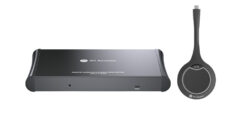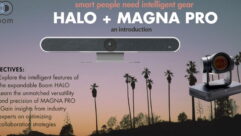
Casting A Wider Net
Crossroads Community Church in Adrian, Mich., a ?portable? church using audio and video components that are stowed after each event, Crossroads is burdened by neither worship traditions nor the need for an elaborate physical space. Like a growing number of technology consumers, Crossroads turns to the Internet to research and acquire the AV equipment it needs.
Pete Bishop, pastor of technical services for Crossroads Community Church in Adrian, Mich., is one of many end-users increasingly turning to the Web to research, comparison shop, and even purchase AV gear. A “portable” ministry, Crossroads uses audio and video components that are stowed after each event. Of these products, Bishop routinely buys mixing boards, switchers, projectors, and cables online.
Crossroads Community Church in Adrian, Mich., epitomizes the contemporary worship trend that’s sweeping the nation’s faith communities. A “portable” church using audio and video components that are stowed after each event, Crossroads is burdened by neither worship traditions nor the need for an elaborate physical space. But the way Crossroads defines “church” isn’t the only example of its contemporary leanings. It’s also pretty hip when it comes to sourcing the AV gear essential to bringing its Sunday services and other activities to life. Like a growing number of technology consumers, Crossroads turns to the Internet to research and acquire the AV equipment it needs.
“I’d say 99 percent of what we need is purchased online, and we’re looking online more all the time,” says Pete Bishop, pastor of technical services for the church. “We’ve purchased mixing boards, switchers, projectors, cables, and batteries — almost everything we need for our portable environment — online.”
Still, there are times when Bishop, a longtime audiophile, needs the advice and assistance of an AV professional. At that point, he seeks out a consultant specializing in house-of-worship applications. However, when the he needs less technical help, he can often get good advice from help desk technicians at his main online supplier of AV gear.
The Online Landscape
More pro AV end-users may be looking to emulate Bishop’s method of using both the Web and systems integrators to meet their AV needs — and suppliers appear to be heeding the call.
True, the Internet is far from supplanting traditional channels in which AV systems integrators, brick-and-mortar dealers, big-box retailers, and manufacturers sell gear via printed catalogs, consultations, competitive bidding, and integration services. But Web-savvy end-users may be in the process of prodding some of these suppliers to create a more robust online presence that transfers more control of the process of information gathering, comparison shopping, and buying into their own hands.
The Web’s possible emergence as a more viable sales channel for gear has potentially far-reaching implications. On the one hand, it could spur sales of more pro AV products by making them easier, and possibly less expensive, to buy. On the other hand, easier access to products holds some potential to take a bigger bite out of systems integrators’ component sales —an area of their business that has already taken a hit in recent years due to commoditization and shrinking profit margins. Of course, it could also upend complex relationships that exist between manufacturers, dealers, integrators, and end-users.
Although concrete figures on just how much gear is being sold online are scant, there’s ample evidence that the Web is playing a greater role in the sale of products to pro AV end-users. In fact, a recent survey of Pro AV magazine readers revealed about 25 percent of systems integrators use the Web to sell some volume of gear. Combine that statistic with more Web-centric IT gear vendors, such as Dell and CDW, edging into select AV gear, and the emergence of AV product distributors with a more commanding online presence, and it’s a good bet that more everyday AV gear transactions have some online DNA.
Contractors Edge Online
Integrators — such as CEAVCO Audio Visual, a Denver-based systems integrator — occupy one of the most potentially vulnerable positions with respect to emerging online sales. CEAVCO, however, uses a “products” section of its Web site to generate product sales as well as leads for its integration business, says Tony DiIorio, the company’s inside sales rep.
CEAVCO doesn’t sell products online via a shopping cart and credit card format. Instead, it directs visitors to an online catalog that contains descriptions of products and suggested retail prices from scores of manufacturers. If a customer wants to explore a purchase, an e-mail request form is generated that captures his or her identity and contact information, a first step to further give-and-take via phone or e-mail, DiIorio says. Some of the products in CEAVCO’s online catalog are made by some 20 manufacturers that offer special pricing deals to it and other companies that belong to the Tulsa, Okla.-based Professional Systems Network (PSNI), an alliance of about 30 AV systems integrators. While CEAVCO sells the gear only, DiIorio regularly uses inquiries to size up potential systems integration business, either for itself or other PSNI members, which may be forwarded leads that are out of CEAVCO’s area.
“This selling feature gives end-users a chance to test us with this service and then come back for more in the way of integration services possibly,” DiIorio says. “If anything, I think it’s helped promote our integration business.”
That’s part of the thinking behind a concept that “AV Bluebook” has brought to some 400 AV service and product dealers — CEAVCO included. A national AV gear distributor representing 350 manufacturers, the Cambridgeport, Vt.–based company has established a service that allows member dealers to piggyback on the Web version of its comprehensive AV gear catalog.
Visitors to product-sales sections of member-dealer Web sites actually access the Bluebook’s listings of some 5,000 SKUs, but they never see the “AV Bluebook” name. By simplifying the complex job of offering an online catalog, this connection gives dealers an opportunity to sell more gear and work with existing and potential integration clients who want to research products online, says Shelly Goldstein, president of Vcom International Multimedia Corp., the parent company of “AV Bluebook” based in South Hackensack, N.J.
“The concept addresses concerns that more integrators have over end-users bypassing them,” says Goldstein. “The idea is to keep the dealer in the loop by letting him take a customer to the site, show him products, and quote a price that only the dealer can access in a password-protected area of the site. Our service helps drive business to dealers and gives the integrator an opportunity to upsell end-users’ installation jobs.”
The “AV Bluebook” online catalog affiliation, while only used to supplement the more extensive manufacturer relationships CEAVCO has cultivated on its own and through PSNI, has proven helpful as part of the company’s total online product information offering, says DiIorio.
“The biggest benefit to all of these affiliations is the ability to compete with the big-box houses that are buying on a national scale,” DiIorio says. “The end-user has an opportunity to spec a list of products and learn more about them.”
While end-users searching for products online may find their way to the “AV Bluebook” Web site, there is no online purchasing functionality — and only nondiscounted list prices are provided, Goldstein says. “If end-users gets to our site and call our toll-free number, we’ll ask them who they’re doing business with, and if we have a dealer in their area, we’ll send them their way.”
Web Snaring More Distributor Customers
Even as more pro AV integrators and dealers look to serve the online browser or buyer, they’re having to watch as more companies leverage the Web directly to get more gear in end-users’ hands. One such reseller, Projector People, the e-commerce division of Audio Visual Innovations (AVI), a systems integrator based in Tampa, Fla., started selling projectors and related gear online in 1999 — and has expanded into plasma displays, flat-panel TVs, and home theater equipment. Open to any buyer, the site is tapping into a growing contingent of pro AV end-users inclined to look to the Internet first to research and buy select types of gear, says Michelle Oswald, AVI’s vice president of marketing communications.
“As the responsibility for purchasing has shifted to the IT department, there’s a growing comfort level with shopping and buying online,” she says. “Most of our online customers are either adding to their existing pool of gear or purchasing next-generation products, and installing it themselves. So we don’t think online sales of the products we sell are cutting into the systems integrators’ business.”
Likewise, Steve Raslevich, president of Northern Sound & Light, a McKees Rocks, Pa.–based distributor of audio and lighting gear that leverages the Web to sell gear (frequently at a discount to the listed MSRP), says progressive integrators understand that gear sales are becoming less essential to their businesses. Raslevich — whose company’s Web portal offers detailed information on products, including its minimum advertised price, but fills orders for products only by phone or e-mail — says as products become easier to install and the knowledge base grows, more end-users will naturally look online.
“People are learning how to use products like DSP processors, and more end-users like churches have people with sound engineering expertise,” he says. “They’re finding what they need online. There’s no pressure shopping on a Web site.”
Surfing for Gear
That anonymity and freedom to learn and shop at a relaxed pace, as well as the chance to nab a better deal, is why some end-users at least start their hunt for AV gear by logging on.
Dan Noullet, senior media technology specialist at Carnegie-Mellon University in Pittsburgh, says the Web provides a great tool for not only learning about products he might want to buy, but also price discovery. While he ultimately hands most of his large-scale gear business to a Pittsburgh-based integrator that offers some online purchasing capabilities, Noullet says he routinely scours the Net out of curiosity, if nothing else.
“I’ll use it to research products that may meet our needs and to help develop a list of specs that we’ll send out to vendors in search of the best price,” he says. “It’s helped us find some products selling at a margin of just a half-percent.”
John Pfleiderer, academic technology facilities project coordinator at Cornell University in Ithaca, N.Y., says he uses the Internet more for product research than online purchasing. While he says buying more online could save money, the potential headaches of having warranty coverage erode on attractively priced products purchased prior to their deployment and inadequate support in the event of problems limit his Internet purchasing.
“There may be some very good price points out there, but meeting most of our needs through integrators takes more responsibility off our shoulders,” he says. “But the Internet is a good way to comparison shop and find out what street prices are on some products. Knowing list prices helps us when developing RFPs — we don’t want to be in a position of undervaluing a project’s cost.”
While the online space seems to be heading in the direction of being as commerce-friendly to pro AV gear as it has become to products like computers, books, and apparel, hurdles clearly remain. Despite the proliferation of gear-related sites, end-users still find it hard to handle transactions completely in cyberspace for all but the most commoditized products, such as projectors and displays.
With manufacturers concerned about protecting their price points and relationships with distributors and integrators, the day when end-users will be able to routinely fill an electronic shopping cart with everything they need for a conference room, classroom, or church — or even see true street prices online for a wide variety of gear — may be a ways off. For instance, even as Raslevich credits his Web presence as being central to his successful business of reselling pro AV gear, he says it has a ways to go before it becomes the Amazon.com of the AV gear world.
“We still can’t show the price online that we’ll sell most of our products for, which is about 15 percent to 20 percent below the manufacturer’s minimum advertised price — the only one we can display in most cases,” he says. “It annoys our customers that they can’t get the selling price without sending an e-mail; our research has found that one in four of our customers wish they could. People are wanting to do more online.”
Tom Zind is a freelance writer based in Lee’s Summit, Mo. He can be reached at[email protected].










